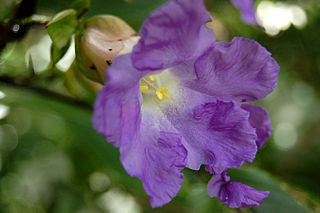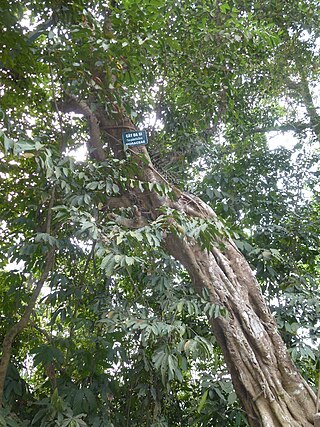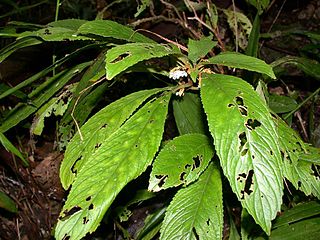
Acanthaceae is a family of dicotyledonous flowering plants containing almost 250 genera and about 2500 species. Most are tropical herbs, shrubs, or twining vines; some are epiphytes. Only a few species are distributed in temperate regions. The four main centres of distribution are Indonesia and Malaysia, Africa, Brazil, and Central America. Representatives of the family can be found in nearly every habitat, including dense or open forests, scrublands, wet fields and valleys, sea coast and marine areas, swamps, and mangrove forests.

Strobilanthes is a genus of about 350 species of flowering plants in the family Acanthaceae, mostly native to tropical Asia and Madagascar, but with a few species extending north into temperate regions of Asia. Many species are cultivated for their two-lipped, hooded flowers in shades of blue, pink, white and purple. Most are frost-tender and require protection in frost-prone areas.

Ruellia is a genus of flowering plants commonly known as ruellias or wild petunias. They are not closely related to petunias (Petunia) although both genera belong to the same euasterid clade. The genus was named in honor of Jean Ruelle (1474–1537), herbalist and physician to Francis I of France and translator of several works of Dioscorides.

Cinnamomum iners is a tree species in the family Lauraceae described by Reinwardt and Blume. No subspecies are listed in the Catalogue of Life. It occurs naturally in Myanmar, Thailand, Laos, Cambodia, Vietnam, Malaysia, Indonesia, Brunei, Singapore, the Philippines and southern China.

Quercus myrsinifolia is an Asian species of tree in the beech family Fagaceae. It has several common names, including bamboo-leaf oak, Chinese evergreen oak, and Chinese ring-cupped oak. Its Chinese name is 小叶青冈; pinyin: xiǎo yè qīng gāng, which means little leaf ring-cupped oak, in Japan it is called white oak and in Korea it is known as gasinamu (가시나무). It is native to east central and southeast China, Japan, Korea, Laos, northern Thailand, and Vietnam. It is placed in subgenus Cerris, section Cyclobalanopsis.

Strobilanthes callosa(Synonym: Carvia callosa Bremek) is a shrub found mainly in the low lying hills of the Western Ghats, all along the west coast of India. Its standardized Hindi name is maruadona (मरुआदोना) which it is called in the state of Madhya Pradesh where it is also found. In the state of Maharashtra, in the Marathi language, and other local dialects and in the neighboring state of Karnataka, the shrub is locally known as karvi (कारवी), sometimes spelled in English as karvy.
Strobilanthes japonica is a flowering herbaceous perennial plant from Asia, one of around 350 plants of the genus Strobilanthes. The 20–50 cm ornamental plant is cultivated in Japan and China, and blooms in autumn with 1.5 cm purple to white funnel-shaped flowers.
Xerospermum is a small genus of Asian plants of the family Sapindaceae.
Artocarpus rigidus is a tree species in the Moraceae that was described by Blume. A. rigidus is a wild species of the breadfruit/jackfruit genus (Artocarpus) and may be referred to as monkey jack. Its Vietnamese name is mít nài.

Anisoptera thurifera is a tree species in the family Dipterocarpaceae. This Asian species has been recorded from Bangladesh through to New Guinea; the IUCN has categorised it as Vulnerable.

Phrynium pubinerve is the type species of the plant genus Phrynium, in the family Marantaceae. It is widespread throughout Asia, with records from India, China, and Indo-China through to New Guinea; no subspecies are listed in the Catalogue of Life.

Ficus glaberrima is an Asian species of fig tree in the family Moraceae. The native range of this species is India, S. China and tropical Asia: Indo-China to the Lesser Sunda Islands. The species can be found in Vietnam: where it may be called đa trụi or đa lá xanh.

Ficus fistulosa is an Asian species of fig tree in the family Moraceae. No subspecies are listed in the Catalogue of Life; its native range is Assam to Taiwan, Indo-China, Malesia and New Guinea. The species can be found in Vietnam: where it may be called sung giòn. It is dioecious, with male and female flowers produced on separate individuals.

Epithema is a genus of plants in the family Gesneriaceae and subfamily Didymocarpoideae. Species distribution records are mostly from western tropical Africa to Uganda, tropical and subtropical Asia.

Rhynchotechum is a genus of plants in the family Gesneriaceae, subfamily Didymocarpoideae. Species distribution records are mostly from India, Sri Lanka, China through to southern Japan, Indo-China and Malesia through to New Guinea.
Dissochaeta is a genus of plants in the family Melastomataceae. Species can be found in: Hainan and Indo-China through to Malesia.

Ficus trichocarpa is a climbing fig species, in the family Moraceae, which can be found in Bangladesh, Indo-China and Malesia. In Vietnam it may be called sung tà.

Ficus heterophylla is a fig plant species, in the family Moraceae, which can be found in India, southern China, Indo-China and western Malesia. In Vietnam it may be called vú bò.

Macaranga denticulata is a species of Asian small trees in the family Euphorbiaceae and tribe Acalypheae, found especially in secondary tropical forests. No subspecies are listed in the Catalogue of Life and the recorded distribution includes: India, southern China, Indo-China and western Malesia.
Quercus lineata is a species of Quercus (oak) in the beech family Fagaceae, belonging to subgenus Cerris, section Cyclobalanopsis. It was first described by Carl Ludwig von Blume.














